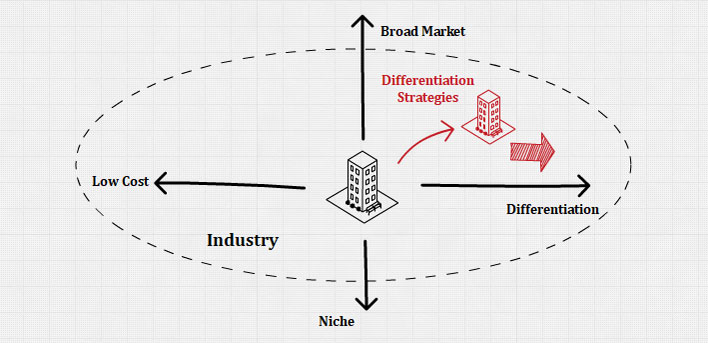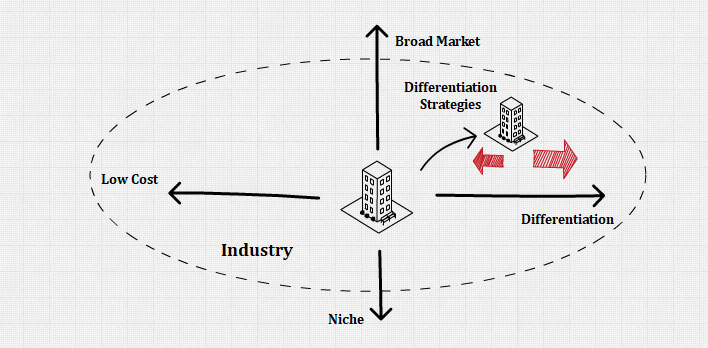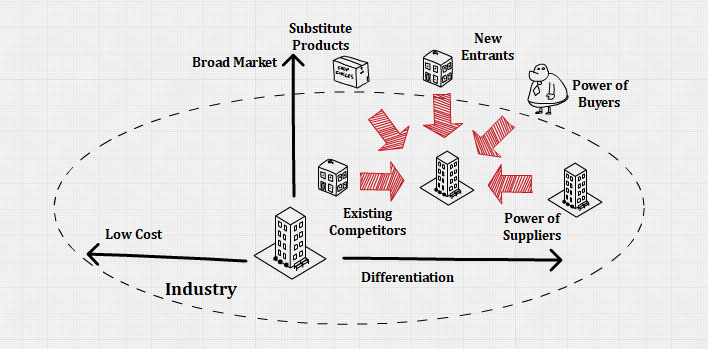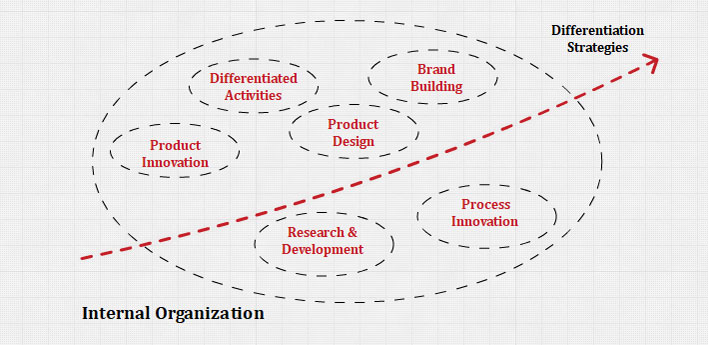Concept of Differentiation Strategy

Definition
The differentiation strategy is an integrated set of actions taken to produce goods or services at an acceptable cost that customers perceive as being different in ways that are important to them.
Using a differentiation strategy means that a firm is competing based on uniqueness rather than price and is seeking to attract a broad market.
A firm following a differentiation strategy attempts to convince customers to pay a premium price for its good or services by providing unique and desirable features. The message that such a firm conveys to customers is that you will pay a little bit more for our offerings, but you will receive a good value overall because our offerings provide something special.
The ability to increase revenues by charging premium prices (rather than by reducing costs as the cost leader does) allows the differentiator to outperform its competitors and gain above-average profits. The premium price is usually substantially above the price charged by the cost leader, and customers pay it because they believe the product’s differentiated qualities are worth the difference. Consequently, the product is priced on the basis of what customers are willing to pay for it.
A company that pursues a differentiation strategy strives to differentiate itself along as many dimensions as possible. The less it resembles its rivals, the more it is protected from competition and the wider its market appeal.
All companies should differentiate their products to a certain degree in order to attract customers and satisfy some minimal level of need.
Some companies differentiate their products to a much greater degree than others, and this difference can give them a competitive advantage.
Some companies offer the customer a low-priced product without engaging in much product differentiation. Others seek to endow their product with some unique attribute(s) so that it will satisfy customers’ needs in ways that other products cannot.
Through the differentiation strategy, the firm produces distinctive products for customers who value differentiated features more than they value low cost.
Rather than costs, a firm using the differentiation strategy primarily concentrates on investing in and developing features that differentiate a product in ways that create value for customers.
While cost leaders serve a typical customer in an industry, differentiators target customers for whom value is created by the manner in which the firm’s products differ from those produced and marketed by competitors.
A differentiator chooses a high level of product differentiation to gain a competitive advantage. Product differentiation can be achieved in three principal ways: quality, innovation, and responsiveness to customers.
Examples of Differentiated Products and Services
The uniqueness may be related to the physical characteristics of the product, such as quality or reliability, or it may lie in the product’s appeal to customers’ psychological needs, such as the need for prestige or status.
A good or service can be differentiated in many ways. Unusual features, responsive customer service, rapid product innovations and technological leadership, perceived prestige and status, different tastes, and engineering design and performance are examples of approaches to differentiation.
Reasons to Use This Strategy
Because a differentiated product satisfies customers’ unique needs, firms following the differentiation strategy are able to charge premium prices.
The ability to sell a good or service at a price that substantially exceeds the cost of creating its differentiated features allows the firm to outperform rivals and earn above-average returns.
Objectives of This Strategy
The objective of the differentiation strategy is to achieve a competitive advantage by creating a product that is perceived by customers to be unique in some important way. The differentiated company’s ability to satisfy a customer’s need in a way that its competitors cannot mean that it can charge a premium price— a price considerably above the industry average.
Differentiation also Requires Cost Control

Firms must be able to produce differentiated products at competitive costs to reduce upward pressure on the price that customers pay.
Efforts to improve service to customers depend on the quality of the sales function. A focus on a specific function does not mean, however, that the control of costs is not important for a differentiator. A differentiator does not want to increase costs unnecessarily and tries to keep them somewhere near those of the cost leader.
When a product’s differentiated features are produced at noncompetitive costs, the price for the product may exceed what the firm’s target customers are willing to pay.
Because developing the distinctive competency needed to provide a differentiation advantage is often expensive, a differentiator usually has higher costs than the cost leader. Still, it must control all costs that do not contribute to its differentiation advantage so that the price of the product does not exceed what customers are willing to pay. Because bigger profits are earned by controlling costs and by maximizing revenues, it pays to control costs but not to minimize them to the point of losing the source of differentiation.
Advantages and Disadvantages of Differentiation

Advantages
Differentiation leads to brand loyalty: Differentiation safeguards a company against competitors to the degree that customers develop brand loyalty for its products. Brand loyalty is a very valuable asset that protects the company on all fronts.
To the extent that differentiation remains in place over time, brand loyalty may be created. Loyal customers are very desirable because they are not price-sensitive. In other words, brand loyalty makes a customer unlikely to switch to another firm’s products if that firm tries to steal the customer away through lower prices.
Differentiation reduces the power of suppliers: Powerful suppliers are rarely a problem because the differentiated company’s strategy is geared more toward the price it can charge than toward the costs of production. Thus, a differentiator can tolerate moderate increases in the prices of its inputs better than the cost leader can.
Differentiation deals with the power of buyers effectively: Differentiators are unlikely to experience problems with powerful buyers because the differentiator offers the buyer a unique product. Only it can supply the product, and it commands brand loyalty.
Differentiation creates a barrier of entry: Differentiation and brand loyalty also create a barrier to entry for other companies seeking to enter the industry. New companies are forced to develop their own distinctive competency to be able to compete, and doing so is very expensive.
Specifically, the brand loyalty that customers feel to a differentiated product makes it difficult for a new entrant to lure these customers to adopt its product. Thus a differentiation strategy helps create barriers to entry that protect the firm and its industry from new competition.
Differentiation lowers the threat of substitute products: The threat of substitute products depends on the ability of competitors’ products to meet the same customer needs as the differentiator’s products and to break the differentiator’s customers’ brand loyalty.
Differentiation helps firms obtain strong profit margins: Differentiation a key advantage is that effective differentiation creates an ability to obtain premium prices from customers. This enables a firm to enjoy strong profit margins. In turn, strong margins also mean that the firm does not need to attract huge numbers of customers to have a good overall level of profit.
Disadvantages
Differentiation is hard to be maintained in long term: The main problems with a differentiation strategy center on the company’s long-term ability to maintain its perceived uniqueness in customers’ eyes. Patents and first-mover advantages (the advantages of being the first to market a product or service) last only so long, and as the overall quality of products made by all companies increases, brand loyalty declines.
Differentiation Strategy in Five Force Model

Rivalry with Existing Competitors
Customers tend to be loyal purchasers of products differentiated in ways that are meaningful to them. As their loyalty to a brand increases, customers’ sensitivity to price increases is reduced.
The relationship between brand loyalty and price sensitivity insulates a firm from competitive rivalry. Thus, reputations can sustain the competitive advantage of firms following a differentiation strategy.
Bargaining Power of Buyers
The distinctiveness of differentiated goods or services reduces customers’ sensitivity to price increases. Customers are willing to accept a price increase when a product still satisfies their unique needs better than a competitor’s offering.
Bargaining Power of Suppliers
Because the firm using the differentiation strategy charges a premium price for its products, suppliers must provide high-quality components, driving up the firm’s costs. However, the high margins the firm earns in these cases partially insulate it from the influence of suppliers in that higher supplier costs can be paid through these margins.
Alternatively, because of buyers’ relative insensitivity to price increases, the differentiated firm might choose to pass the additional cost of supplies on to the customer by increasing the price of its unique product.
However, when buyer firms outsource the total function or large portions of it to a supplier, especially R&D for a firm following a differentiation strategy, they can become dependent on and thus vulnerable to that supplier.
Potential Entrants
Customer loyalty and the need to overcome the uniqueness of a differentiated product create substantial barriers to potential entrants. Entering an industry under these conditions typically demands significant investments of resources and patience while seeking customers’ loyalty.
In these cases, some potential entrants decide to make smaller investments to see if they can gain a foothold in the market. If it does not work they will not lose major resources, but if it works they can then invest greater resources to enhance their competitive position.
Product Substitutes
Firms selling brand-name goods and services to loyal customers are positioned effectively against product substitutes. In contrast, companies without brand loyalty face a higher probability of their customers switching either to products that offer differentiated features that serve the same function (particularly if the substitute has a lower price) or to products that offer more features and perform more attractive functions.
As such, firms may be vulnerable to innovations from outside the industry that better satisfy customers’ needs.
Risks of the Differentiation Strategy

One risk of the differentiation strategy is that customers might decide that the price differential between the differentiator’s product and the cost leader’s product is too large. Customers will not be willing to pay extra to obtain the unique features that a firm is trying to build its strategy around. In this instance, a firm may be offering differentiated features that exceed target customers’ needs. The firm then becomes vulnerable to competitors that are able to offer customers a combination of features and price that is more consistent with their needs.
Another risk of the differentiation strategy is that a firm’s means of differentiation may cease to provide value for which customers are willing to pay.
Sometimes, customers desire the unique features that a firm offers, but competitors are able to imitate the features well enough that they are no longer unique. If this happens, customers have no reason to pay a premium for the firm’s offerings. A differentiated product becomes less valuable if imitation by rivals causes customers to perceive that competitors offer essentially the same goods or services, but at a lower price.
A third risk of the differentiation strategy is that experience can narrow customers’ perceptions of the value of a product’s differentiated features.
Counterfeiting is the differentiation strategy’s fourth risk. Counterfeits are products that are labeled with a trademark or logo that is identical to or indistinguishable from a legal logo owned by another party, thus infringing the rights of the legal owner. When a consumer purchases such a product and discovers the deception, regret creates distrust of the branded product and reduces differentiation.
What Firms Need for Differentiation Strategy

To maintain success with the differentiation strategy results, the firm must consistently upgrade differentiated features that customers value and/or create new valuable features (i.e., innovate) without significant cost increases.
Firms can have an effective differentiation strategy and help it earn above-average returns if it has a thorough understanding of what its target customers value, the relative importance they attach to the satisfaction of different needs, and what they are willing to pay a premium.
Production innovation is an important factor for differentiation strategy: Product innovation is the result of bringing to life a new way to solve the customer’s problem, through a new product or service development, that benefits both the customer and the sponsoring company. Product innovation is critical to the successful use of the differentiation strategy.
Product design is an important source of differentiation: Because product design can create a positive experience for customers, it is an important source of differentiation (even for cost leaders seeking to find ways to add functionalities to their low-cost products as a way of differentiating their products from competitors) and, hopefully, for firms emphasizing it, of competitive advantage.
Value chain analysis is critical for differentiation strategy: The value chain can be analyzed to determine if a firm is able to link the activities required to create value by using the differentiation strategy. Companies without the skills needed to link these activities cannot expect to successfully use the differentiation strategy.
Advertising and brand building are important to differentiation strategy: Successful use of a differentiation strategy depends on not only offering unique features but also communicating the value of these features to potential customers. As a result, advertising in general and brand building, in particular, are important to this strategy. Few goods are more basic and generic than table salt. This would seemingly make creating a differentiated brand in the salt business next to impossible.
Differentiation advantage is important for firms to pursuit differentiation strategy: Generally, a differentiator chooses to segment its market into many niches. Now and then a company offers a product designed for each market niche and decides to be a broad differentiator, but a company might choose to serve just those niches in which it has a specific differentiation advantage.
In choosing which distinctive competency to pursue, a differentiated company concentrates on the organizational function that provides the sources of its differentiation advantage. Differentiation on the basis of innovation and technological competency depends on the R&D function.
Resources
Further Reading
- Differentiation Strategy: What It Is, Why It’s Critical, and How To Get It Right (cxl.com)
- Differentiation Strategy: Definition, Benefits and Creation (indeed.com)
- Amazing Differentiation Strategy Examples (mktoolboxsuite.com)
- Differentiation Strategy (cio-wiki.org)
- Powerful Differentiation Strategy Examples for Brand Positioning )brandmasteracademy.com)
- The Pros and Cons of a Differentiation Business Strategy (advancepointcap.com)
- How to Create a Differentiation Strategy (adroll.com)
- What is a Differentiation Strategy? (zippia.com)
- Find your product differentiation strategy using an analytical framework (roadmunk.com)
Even More Reading
- Using Differentiation to Stand Out From the Competition (business2community.com)
- Differentiation strategy: how-to, types and examples (awware.co)
- Differentiation Strategies to Make You Stand Out From Your Competitors (smallbusinessbonfire.com)
Related Concepts
- Business-Level Competitive Strategies
- Cost Leadership Strategy
- Focus Strategy
- Integrated Best Cost Strategy
References
- Hitt, M. A., Ireland, D. R., & Hoskisson, R. E. (2016). Strategic Management: Concepts: Competitiveness and Globalization (12th ed.). Cengage Learning.
- Mastering Strategic Management. (2016, January 18). Open Textbooks for Hong Kong.
- Wheelen, T. L. (2021). Strategic Management and Business Policy: Toward Global Sustainability 13th (thirteenth) edition Text Only. Prentice Hall.